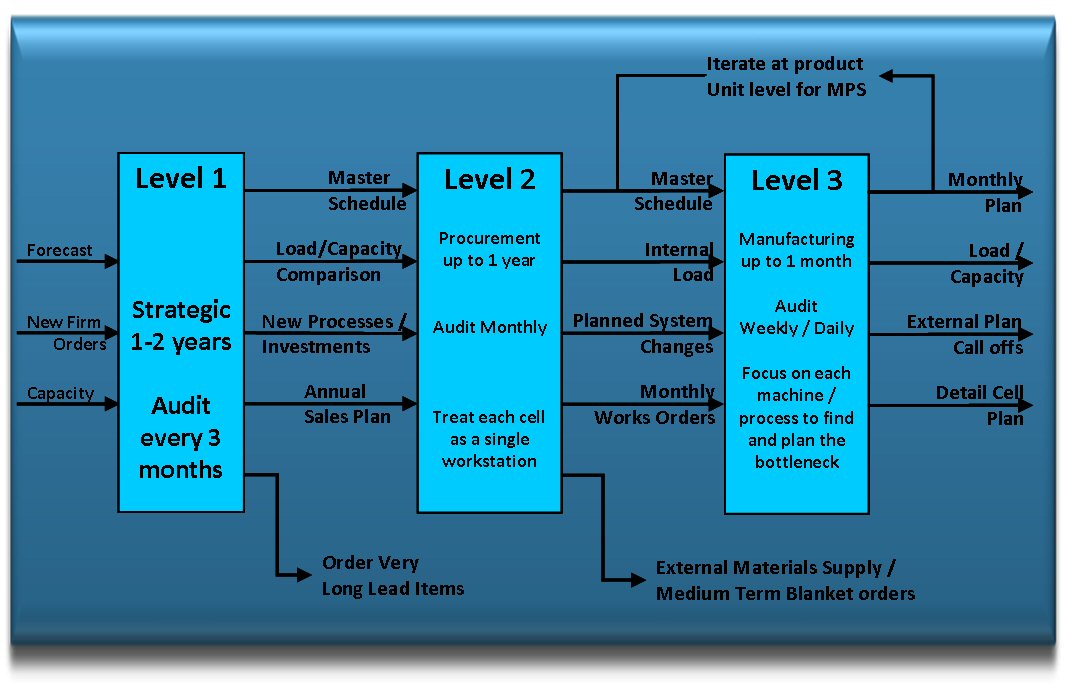5.13 - Scheduling – Meeting Customer Requirements
A schedule is a list of instructions specifying:-
- What should be done
- By whom (supplier, resources, labour, machines)
- How many - in what quantity and batch sizes (e.g. Kanban container or Period Flow container)
- By when
See guide 7.18 for further information on MRP II.
When Kanban is in place, workload levelled scheduling is done for all cells, but instructions are only issued to the final output cell, typically assembly.
Schedules should be levelled (see guide 5.14) to obtain the full benefit from the simple cellular product group modules and obtain competitive performance from these modules.
Levelled Scheduling does not require constant demand from customers although, clearly anything the Sales Manager can do in working with customers to plan for reduced variability will be a great help. Levelled scheduling interleaves different product demands to match capacity and moves resources to match workload.
Schedules
Levelled scheduling needs to be carried out at three levels:-
Strategic Planning - the long term balance of business capacity and load (long term plan of 1 - 2 years)
Master Production Schedule (MPS) Planning - the period for which firm orders are required by suppliers.
Shop Floor / Cell Planning - detailed balance of cell capacity and load (short term planning up to one month rolling a week at a time).
Note that the higher levels of scheduling (e.g. strategy) deal in longer time spans - the lower levels (e.g. manufacturing) in shorter lead times. At strategy and procurement levels such decisions as how to source supply from a multi-site business or when to change manufacturing strategy by changing the mix of machines and processes to suit product mix changes can be made.
Objectives
Each level of scheduling has the following objectives:-
Strategy Level
- Check sufficient capacity or
- Check sufficient orders
- Support strategic decisions on products, markets and investments
Procurement Level
- Structure orders into Runners, Repeaters and Strangers by demand
- Ensure demand is actually planned in the sequence required by the customer (i.e. NOT batched up and made for stock).
- By negotiation with cells establish a bought-out parts schedule via material requirements planning (MRP)
Manufacturing Level
- Identify bottleneck manufacturing processes using a work load calculation method (e.g. spreadsheet, simulation etc)
- Structure the load to maximise effectiveness of bottleneck by interleaving runners, repeaters and strangers each week and each day up to the level of the bottleneck capacity, making allowance for changeover times.
Schedules must be valid, which requires them to be:-
- Productive and meet company goals
- Realistic and achievable with existing resources (i.e. within capacity for each cell)
- Robust and immune to temporary / fluctuating production constraints.
- Constructed for each cell in a product unit first taking account of current mix and load and finalised iteratively in a cell controllers meeting to produce a product unit Master Production Schedule (MPS)
Calculation of Schedules at Cell Level
Two types of information are required, supported by a database of the work contents of each component and assembly:-
- Workload against machine or process each day
- Weekly bar diagram showing proportion of runners, repeaters and strangers each day
Three Levels of Scheduling
